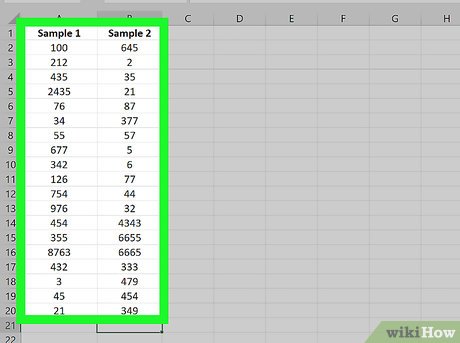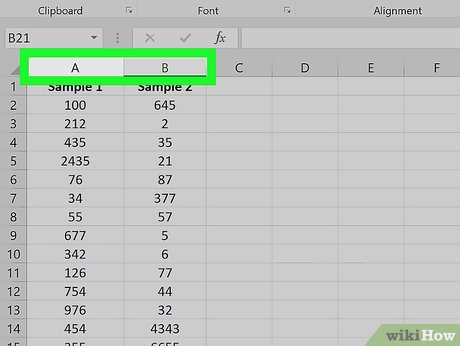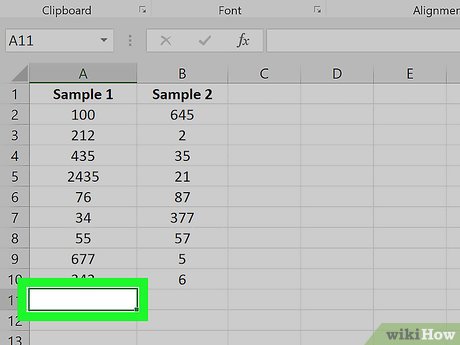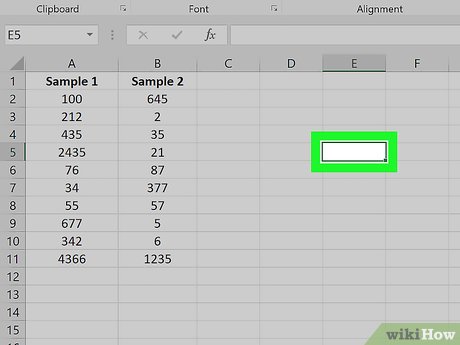How to Add Up Columns in Excel
Method 1 of 2:
Using the Columns
-
 Open your Excel document. Double-click the Excel document that you want to edit. Doing so opens it in Excel.
Open your Excel document. Double-click the Excel document that you want to edit. Doing so opens it in Excel. -
 Determine which of your columns is the longest. In order to include all of the cells in the longest column, you'll need to know to which row the column extends.
Determine which of your columns is the longest. In order to include all of the cells in the longest column, you'll need to know to which row the column extends.- For example, if you have three columns and the longest one has values from row 1 through row 20, your formula will need to include rows 1 through 20 for each column you want to add even if this includes blank cells.
-
 Determine your beginning and ending columns. If you're adding the A column and the B column, for example, your beginning column is the A column and your ending column is the B column.
Determine your beginning and ending columns. If you're adding the A column and the B column, for example, your beginning column is the A column and your ending column is the B column. -
 Select a blank cell. Click the cell in which you want to display the sum of your columns.
Select a blank cell. Click the cell in which you want to display the sum of your columns. -
 Enter the "SUM" command. Type =SUM( ) into the cell.
Enter the "SUM" command. Type =SUM( ) into the cell. -
 Enter the cell range. In the parentheses, type in the beginning column's top cell number, type a colon, and type in the ending column's letter along with the longest column's ending row.
Enter the cell range. In the parentheses, type in the beginning column's top cell number, type a colon, and type in the ending column's letter along with the longest column's ending row.- For example, if you're adding columns A, B, and C, and your longest column stretches to row 20, you would enter the following: =SUM(A1:C20)
-
 Press ↵ Enter. Doing so will display the sum of all of the columns in your selected cell.
Press ↵ Enter. Doing so will display the sum of all of the columns in your selected cell.
Method 2 of 2:
Using Separate Cells
-
 Open your Excel document. Double-click the Excel document that you want to edit. Doing so opens it in Excel.
Open your Excel document. Double-click the Excel document that you want to edit. Doing so opens it in Excel. -
 Click a cell below one of the columns you want to add. Doing so will place your cursor in the cell.
Click a cell below one of the columns you want to add. Doing so will place your cursor in the cell. -
 Enter the "SUM" command. Type =SUM( ) into the cell.
Enter the "SUM" command. Type =SUM( ) into the cell. -
 Enter the column's range. Type the top cell in the column, a colon, and the bottom cell in the column into the parentheses.
Enter the column's range. Type the top cell in the column, a colon, and the bottom cell in the column into the parentheses.- For example, if you're adding values in the A column and you have data in cells A1 through A10, you would type in the following: =SUM(A1:A10)
-
 Press ↵ Enter. This will display the sum of the column in your selected cell.
Press ↵ Enter. This will display the sum of the column in your selected cell. -
 Create the sums of the other columns you want to add. Once you have the sum of each column below the columns in question, you can proceed.
Create the sums of the other columns you want to add. Once you have the sum of each column below the columns in question, you can proceed. -
 Select an empty cell. Click the cell in which you want to display the sum of the columns you're adding together.
Select an empty cell. Click the cell in which you want to display the sum of the columns you're adding together. -
 Add together the cells in which you created the sums of the columns. You can do this by entering each cell's letter and number into the "SUM" command.
Add together the cells in which you created the sums of the columns. You can do this by entering each cell's letter and number into the "SUM" command.- For example, if you have the sum of each column in cells A11, B23, and C15, you would type =SUM(A11,B23,C15) into the empty cell.
-
 Press ↵ Enter. Doing so will display the sum of all of the columns in your selected cell.
Press ↵ Enter. Doing so will display the sum of all of the columns in your selected cell.
5 ★ | 1 Vote
You should read it
- Tips for handling columns in Microsoft Word
- How to Compare Data in Excel
- Format column text in Word
- How to split columns in Excel
- MS Excel 2007 - Lesson 10: Modify columns, rows and cells
- MS Excel - Lesson 4: Working with lines, columns, sheets
- How to fix columns in Excel
- How to split first and last names into 2 columns in Excel
May be interested
- MS Excel - Lesson 4: Working with lines, columns, sheets
 in addition to the content of tables in excel, operations with lines, columns and sheets in this program are also important. in this article, tipsmake.com will guide you to simple operation to add or remove lines, columns or sheets in excel tables.
in addition to the content of tables in excel, operations with lines, columns and sheets in this program are also important. in this article, tipsmake.com will guide you to simple operation to add or remove lines, columns or sheets in excel tables. - Lock one or more data columns on Excel worksheet - Freeze data in Excel
 to lock one or more data columns in excel worksheet, you do as follows: open the sheet containing the data columns to be locked, then select all sheets by pressing ctrl + a. right-click and choose format cells ...
to lock one or more data columns in excel worksheet, you do as follows: open the sheet containing the data columns to be locked, then select all sheets by pressing ctrl + a. right-click and choose format cells ... - How to delete rows and columns in Excel with mouse or key
 excel is an important and indispensable tool in the work process. however, editing data or deleting rows and columns in excel can be quite complicated for some new users. therefore, to help make work more efficient, we will introduce to readers how to delete rows and columns in excel using the mouse or keys in detail in the article below.
excel is an important and indispensable tool in the work process. however, editing data or deleting rows and columns in excel can be quite complicated for some new users. therefore, to help make work more efficient, we will introduce to readers how to delete rows and columns in excel using the mouse or keys in detail in the article below. - How to change the position of columns in Excel
 to change the position of two columns, swap multiple column positions in excel, we can use two ways that are using cut & copy or drag & drop operations.
to change the position of two columns, swap multiple column positions in excel, we can use two ways that are using cut & copy or drag & drop operations. - How to split first and last names into 2 columns in Excel
 how to split first and last names into 2 columns in excel. in the process of compiling data, sometimes you need to split the first name column into two first and last column columns to serve different purposes, for example, to sort the list by alpha b. thuthuatphanmem.vn will be directed.
how to split first and last names into 2 columns in excel. in the process of compiling data, sometimes you need to split the first name column into two first and last column columns to serve different purposes, for example, to sort the list by alpha b. thuthuatphanmem.vn will be directed. - Types of data hiding in Excel - Hide pictures, graphs, rows, columns
 tipsmake introduce to you part 3: how to hide photos, graphs, drawings, lines, columns in excel
tipsmake introduce to you part 3: how to hide photos, graphs, drawings, lines, columns in excel - Instructions for separating column content in Excel
 to separate content in an excel field into different columns, we can use two different ways.
to separate content in an excel field into different columns, we can use two different ways. - MS Excel 2007 - Lesson 10: Modify columns, rows and cells
 when you open a new blank workbook in excel 2007, cells, columns, and rows are set to default sizes. you can change the size of each cell, column and row, as well as insert new columns, rows and cells if needed.
when you open a new blank workbook in excel 2007, cells, columns, and rows are set to default sizes. you can change the size of each cell, column and row, as well as insert new columns, rows and cells if needed. - How to handle cells, columns, rows in a spreadsheet in Excel
 the following article will guide you in detail how to handle cells, columns, rows in spreadsheets in excel. 1. change the width of columns, rows and cells in excel. 1.1 resize a row or a column: - hold down the left mouse button for the vertical part of the column and drag the cycle
the following article will guide you in detail how to handle cells, columns, rows in spreadsheets in excel. 1. change the width of columns, rows and cells in excel. 1.1 resize a row or a column: - hold down the left mouse button for the vertical part of the column and drag the cycle - How to temporarily hide rows and columns in Excel 2013
 excel 2013 has a feature that allows temporary users to hide one or more rows / columns in an excel spreadsheet. this feature is very useful in case you only want to print a part of the spreadsheet but do not want to delete other excess rows and columns.
excel 2013 has a feature that allows temporary users to hide one or more rows / columns in an excel spreadsheet. this feature is very useful in case you only want to print a part of the spreadsheet but do not want to delete other excess rows and columns.



















 How to Search for Words in Excel
How to Search for Words in Excel How to Unshare an Excel Workbook
How to Unshare an Excel Workbook How to Use the Sum Function in Microsoft Excel
How to Use the Sum Function in Microsoft Excel How to Integrate Large Data Sets in Excel
How to Integrate Large Data Sets in Excel How to Make Tables Using Microsoft Excel
How to Make Tables Using Microsoft Excel How to Create a Random Sample in Excel
How to Create a Random Sample in Excel